
Definition of Igneous Rocks
Igneous rocks are crystalline rocks created by the cooling and crystallization of molten earth material (magma), whether deep in the Earth or blasted out during an eruption. They comprise one of the three principal classes of rocks, the others being metamorphic and sedimentary. Igneous rocks are formed from the solidification of magma, which is a hot (600 to 1,300 °C, or 1,100 to 2,400 °F) molten or partially molten rock material. They have lots of distinct textures and colors depending on their chemical content and formation.
Earth is composed predominantly of a large mass of igneous rock with a very thin veneer of weathered material—namely, sedimentary rock.
The study of igneous rock is a study of magma since igneous rock comes from cooled magma that has made its way to the Earth’s surface. But not all magma is created equally. Depending on the time of heating and method of getting to the surface, different cooled magmas form rocks that look very different from each other.
When scientists started studying igneous rock in the laboratory, they found two simple ways to separate igneous rock samples, texture, and chemical composition. However, there are other criteria, such as crystal or grain size, color, mineralogy, mode of occurrence, and genesis.
How Igneous Rocks Are Formed
The mantle is a very hot layer where the solid rock turns to a molten rock called magma. There’re many places in Earth’s crust that contain cracks and breaks as a result of plate tectonic movement, which are called faults and fissures. At these locations, the magma starts to seep up from the mantle to the surface of the crust.
Not all magma comes from the mantle, though. In some places, such as the subduction zone, material in the crust melts and forms magma chambers closer to Earth’s surface.
When magma rises to Earth’s surface, it becomes known as lava. The lava cools and hardens into a rock- igneous rock. When the igneous rocks and other materials continue to build up, a volcano is formed.
Igneous rocks can form on the dry land of continental crust. They can also form on the seabed at the bottom of the oceanic crust. For example, all the Hawaiian Islands are made up of igneous rocks that formed from underwater volcanoes. The volcanoes started on the ocean floor and grew as a result of millions of years of eruptions. Many types of igneous rocks can be found on these islands, including basalt, obsidian and pumice.
Types of Igneous Rocks
Igneous rocks are classified on the basis of mineralogy, chemistry, and texture. The texture is used to subdivide igneous rocks into two major groups: (1) the plutonic rocks (intrusive), with mineral grain sizes that are visible to the naked eye > 1 mm, and (2) the volcanic (extrusive), which are usually too fine-grained or glassy for their mineral composition to be observed without the use of a petrographic microscope.
1-Intrusive Igneous Rocks
The cooled, crystallized magma that forces its way into the surrounding unmelted rock masses deep in the Earth is called intrusive igneous rock. It can be identified by its interlocking large crystals (grains 1mm or larger), which grow slowly as magma cools over time. Commonly, large mineral grain igneous rock is known as phaneritic.
When this type of rock is formed several kilometers below the surface of the Earth, it is known as plutonic rock. All masses of intrusive igneous rock, whether large or small, are called plutons. They are created on the slow boat of movement to the surface and have a lot of time to solidify and develop their individual unique compositions.
2-Extrusive Igneous Rock
Once magma exits the crust (ejected during an eruption) and cools rapidly, it creates a finely textured or glassy rock with small crystals. Basalt is an example of igneous rock that is quickly cooled from magma and extruded at the surface from lava.
Extrusive igneous rock is on the rocket ship of movement to the surface. These rocks are commonly called volcanic rocks since they blast to the surface as either lava or rock fragments from your local neighborhood volcano. When the grains in the igneous rock are not easily seen, even with a magnifying glass, the rocks are called aphanites.
Classification based on chemical or mineral composition
Igneous rocks are divided into four types depending on composition: felsic, intermediate, mafic, and ultramafic.
1-Felsic Igneous Rocks
The first igneous rock type, felsic, is made up of light-colored igneous rocks that have high levels of silica-containing minerals like quartz and feldspar – The name felsic comes from a combination of the words feldspar and silica.
Granite and granodiorites are the best-known and most frequently seen intrusive igneous rocks containing about 70% silica. These mostly light-colored quartz and orthoclase feldspar minerals are found only in the continental crust. When different minerals like quartz and feldspar mixed with granite, it takes on its well-known gray or pink color.
2- Intermediate Igneous Rock
Intermediate igneous rocks have mineral compositions between those of mafic and felsic rocks. They contain about 52 percent to 66 percent silica. Andesite is the best example of intermediate rocks.
3-Mafic igneous rocks
The mafic rock contains high levels of magnesium and ferric (iron-containing) minerals. The word mafic comes from a combination of these two mineral names.
Rocks that are low in silica, but high in magnesium and iron, form dark colored mafic rocks like pyroxenes and olivines. Their main minerals are calcium-rich feldspar and calcium- and magnesium-rich pyroxenes.
The Earth’s ocean floor is made up of basalt. The mafic rock contains only about 50% silica by weight. It is commonly dark gray but can be green, brown, or black.
4-Ultramafic Igneous Rocks
Rocks that are made up of less than 40 percent silica. These rocks contain relatively high proportions of magnesium and iron and have a color index above 90 (containing >90% dark minerals). Peridotite and komatiite are common ultramafic rocks that occur in plutonic and volcanic settings, respectively.
Ultramafic rocks are usually dominated by one or more of the minerals olivine, orthopyroxene, and clinopyroxene.
See the below table for simple classification.
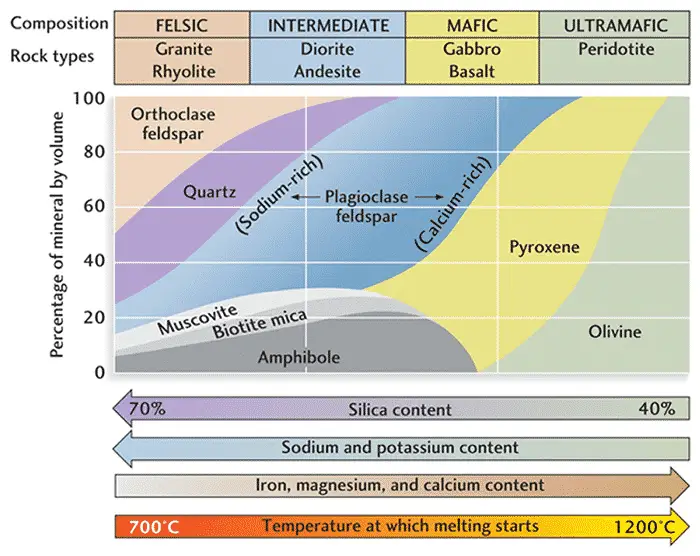
Examples of Igneous Rocks
1-Granite
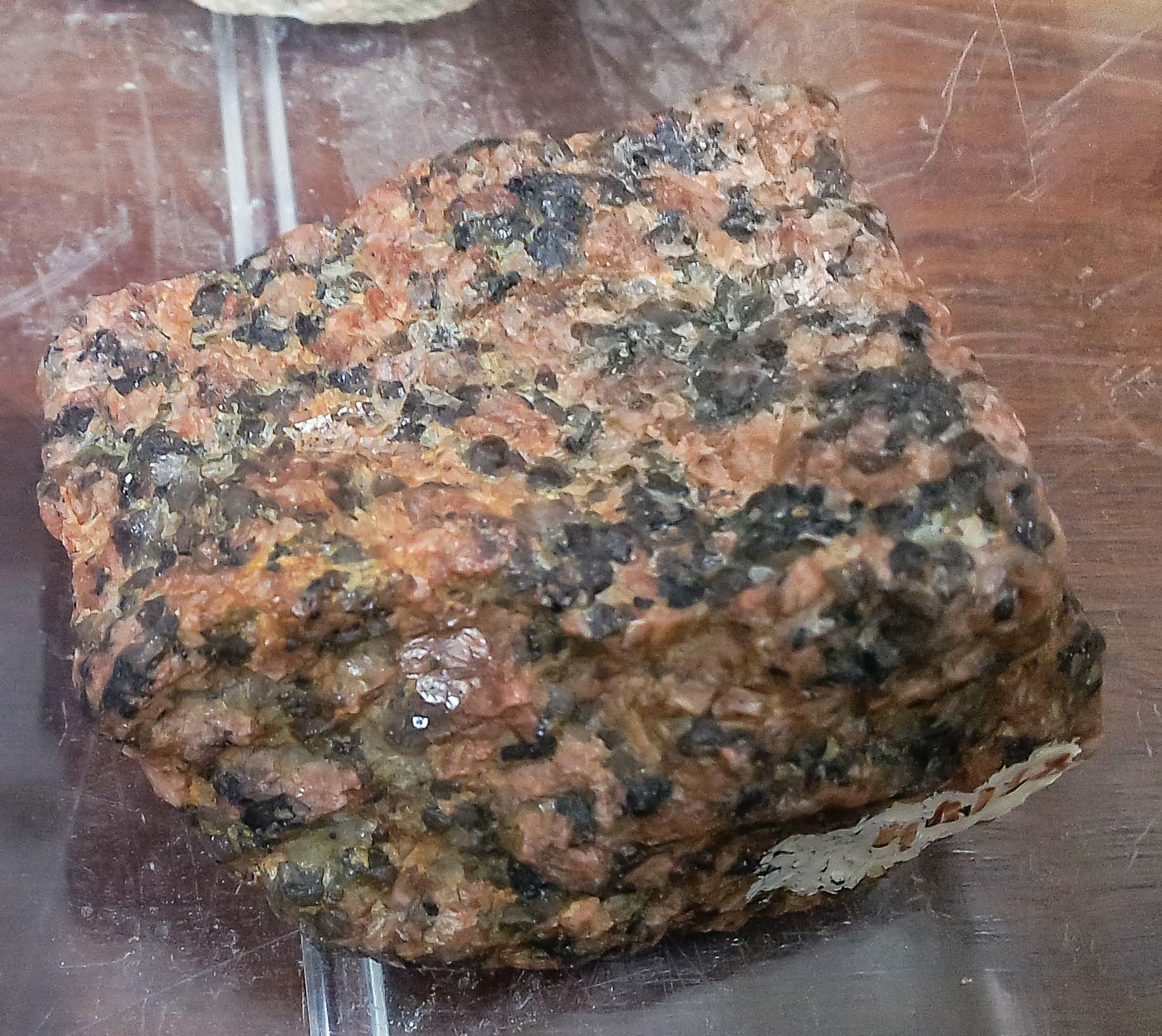 is a common and familiar rock. Its essential minerals can be identified with the naked eye or a hand lens. These are quartz – usually in rounded glassy grains – and feldspars. Feldspars are more or less rectangular, plagioclase, usually white, and alkali feldspars pink. Black grains of hornblende and/or biotite are the most common dark-colored minerals. Granite is a hard-wearing rock and is used as a building stone, both in blocks and in polished slabs.
is a common and familiar rock. Its essential minerals can be identified with the naked eye or a hand lens. These are quartz – usually in rounded glassy grains – and feldspars. Feldspars are more or less rectangular, plagioclase, usually white, and alkali feldspars pink. Black grains of hornblende and/or biotite are the most common dark-colored minerals. Granite is a hard-wearing rock and is used as a building stone, both in blocks and in polished slabs.
2- Pegmatites

are very coarse-grained rocks, mostly of granitic composition, with individual crystals that range from smaller than one centimeter to several meters in size. Quartz and feldspar dominate but many other minerals can form large beautiful crystals. Some gemstones are mined from pegmatites, such as emerald, aquamarine, tourmaline group minerals, and topaz. Other pegmatites contain important ore minerals that are the source of industrial metals, such as lithium, tin, tantalum, and tungsten.
3- Diorite
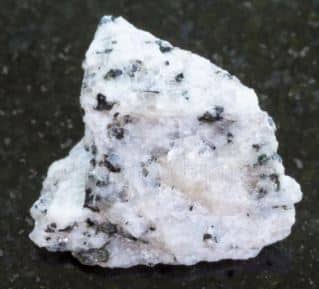
is an intermediate, coarse-grained igneous rock, diorite consists of white plagioclase and dark hornblende in roughly equal proportions, but other dark minerals may include biotite and augite. With the addition of small amounts of quartz and alkali feldspar, it becomes a granodiorite; with larger amounts, it is a granite. These three rock types often occur together in large intrusions.
4- Syenites
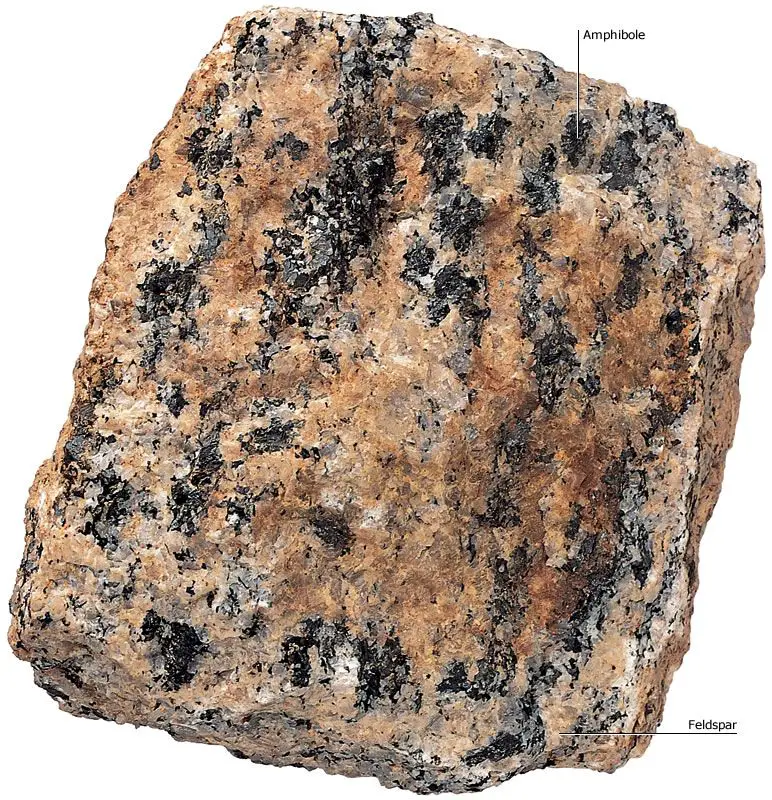
are attractive, multi-colored rocks, which may be polished and used as decorative stones. Alkali feldspar is the main component. Many other minerals, such as plagioclase, biotite, pyroxene, amphibole group minerals, minor quartz, or nepheline, can accompany it.
5-Gabbro
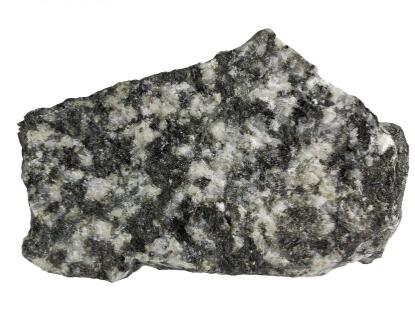
is a dark-colored rock composed of coarse grains of dark green pyroxene (augite and lesser amounts of orthopyroxene), plus white- or green-colored plagioclase and black millimeter-sized grains of magnetite and/or ilmenite. Gabbros occur in thick sills, in uplifted sections of oceanic crust called ophiolites, and with cumulate rocks in layered igneous intrusions.
6- Dolerite
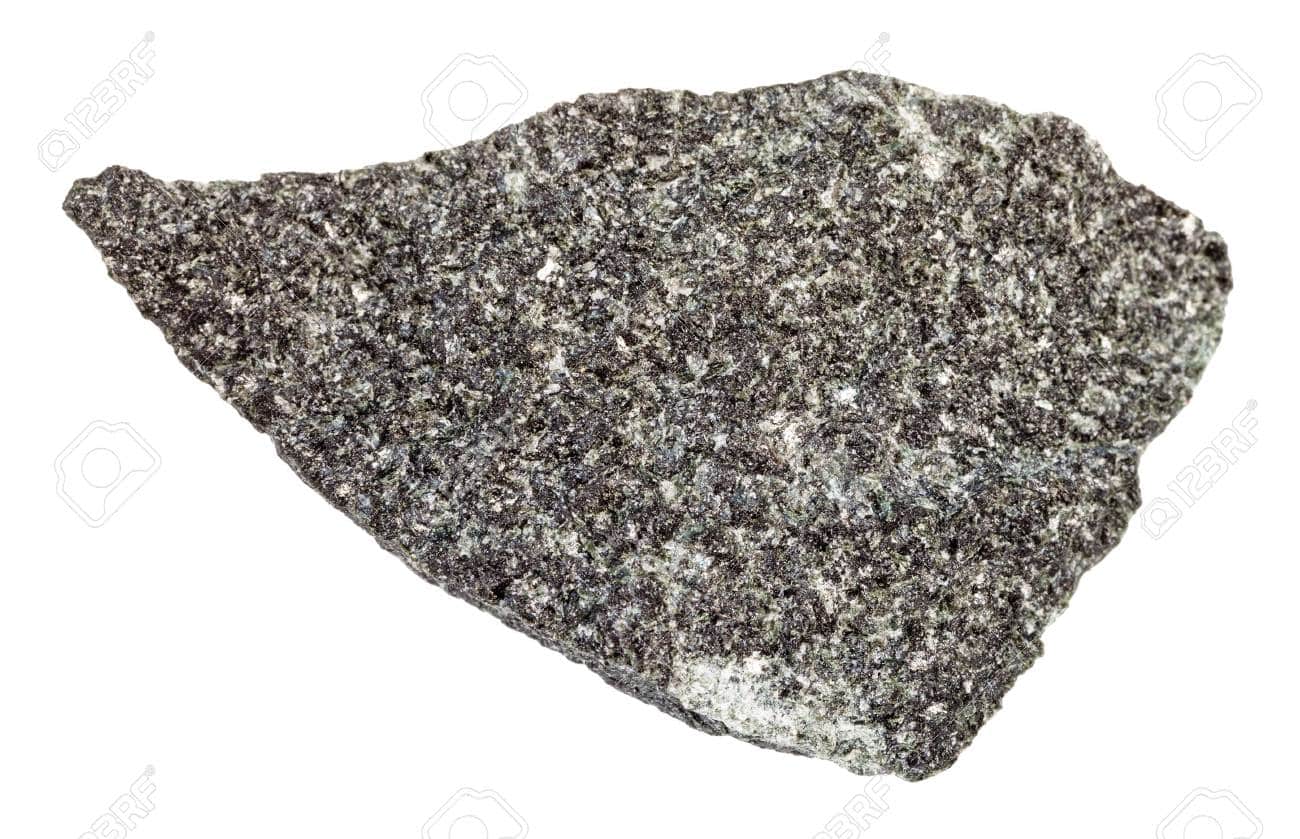
is a medium-grained rock with the same composition as gabbro. It is found in minor intrusions, sills, and dykes. Plagioclase crystals are usually tiny rectangles within larger pyroxene grains. Olivine is a common constituent, in rounded grains often weathered to an orange-brown color. It is a hard and heavy rock, and used polished as a decorative stone, rough for paving and crushed for roadstone.
7- Dunite
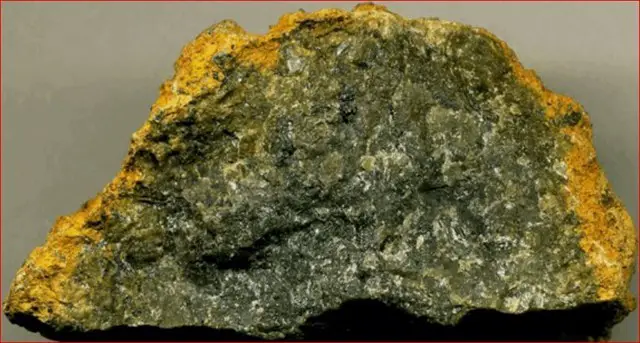
is a green or brown coarse-grained rock consisting almost entirely of the mineral olivine, dunite also contains small black chromite or magnetite grains. In some countries, if it contains magnetite, it is known as olivinite. Dunites are found as cumulate rocks in layered intrusions and also as pipes and irregular bodies. Alteration of dunite by the addition of water produces a serpentinite.
8- Peridotite
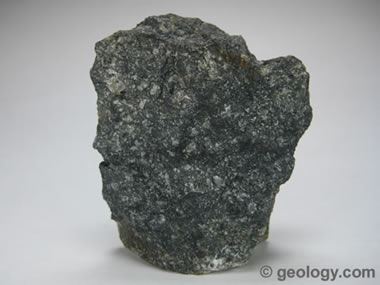
is contains 50–90 percent olivine. It is a coarse-grained light to dark green rock, which usually contains pyroxene. Unlike olivine, pyroxene grains have a visible cleavage when viewed under a hand lens. It forms much of the Earth’s mantle and can occur as nodules brought up from the mantle by basalt or kimberlite magmas. Peridotite also occurs as a cumulate rock.
9- Anorthosite
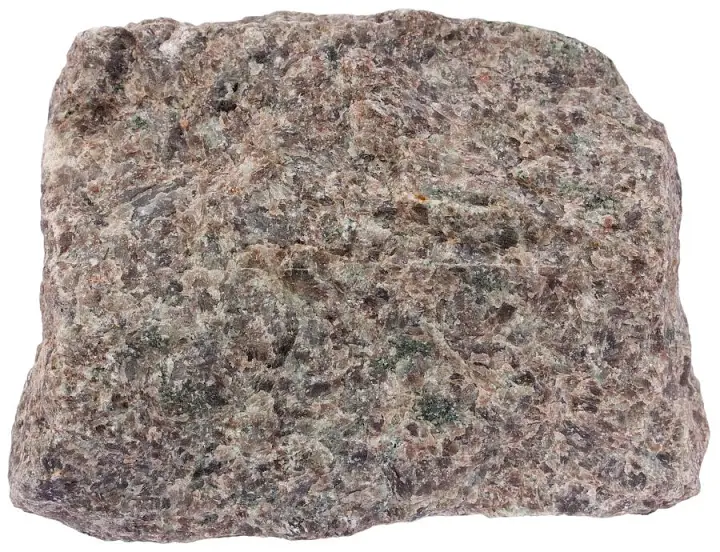
is a coarse-grained rock composed of more than 90 percent feldspar, while pyroxene often forms most of the rest of the rock Anorthosite is white or grey but it can be green colored and has a granular texture. It occurs in layered igneous intrusions as a cumulate rock, but also in large metamorphic gabbro-anorthosite complexes of the Precambrian Era.
10- Kimberlite
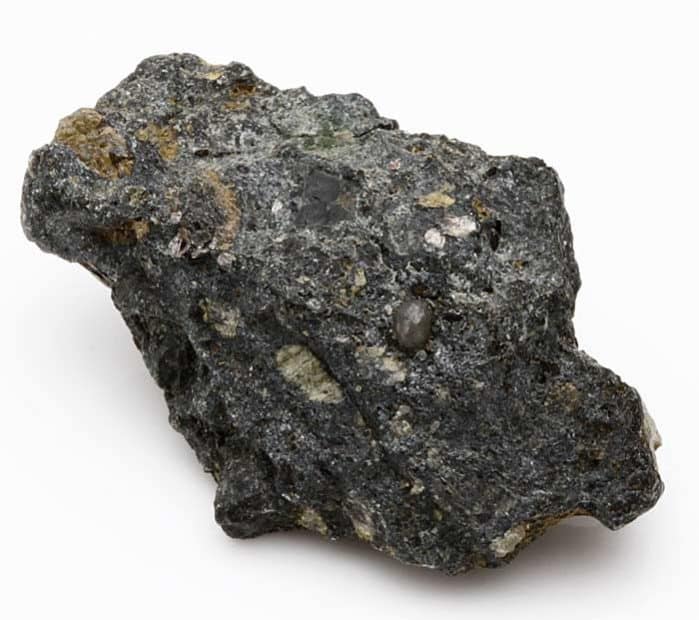
is a rare rock, best known for being the major source of diamonds. It is found in dykes and carrot-shaped pipes called diatremes, up to a kilometer in diameter. When fresh, it is a blue-green color but it weathers to yellow. It is coarse to fine-grained and contains clasts, or is brecciated. Common minerals such as phenocrysts include purple pyrope, bright green chromium-rich diopside, chromite, calcite, and phlogopite.
11- Xenoliths

Magma often incorporates fragments of the country rock through which it passes during the intrusion. These often remain within the igneous rock that forms when the magma cools and solidifies, and are known as xenoliths. Xenoliths are often rounded, may be any size, and may have been metamorphosed.
12- Rhyolite

is a fine-grained, light-colored rock. It is often composed largely of volcanic glass. Individual grains of quartz, feldspar, and mica may be present but are too small to be visible. Sometimes rhyolites are porphyritic with millimeter-scale phenocrysts of quartz and/or feldspar.
The granitic magma from which rhyolite crystallizes is very viscous, and so, flow-banding is often preserved and can be seen on weathered surfaces. Devitrification of glassy rhyolite produces tiny crystals arranged in radiating spheres, usually of a centimeter or so in size: a variety known as spherulitic rhyolite.
13- Obsidian
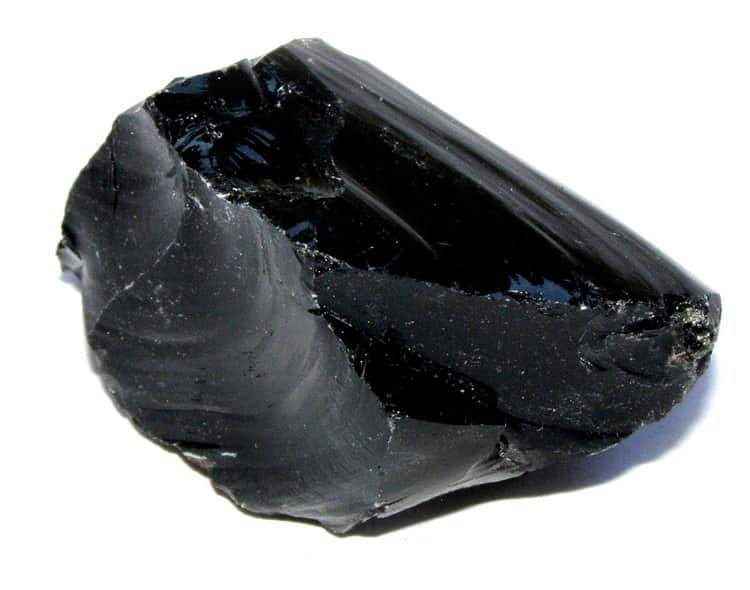
is a black, acid volcanic glass with a well-developed conchoidal fracture, obsidian forms by the rapid cooling of acid lava and is often found with grey pumice. The fragments of the rock are sharp and have been used as cutting implements. A variety with centimeter-scale spheres of tiny white radiating crystals is known as snowflake obsidian.
14- Andesite
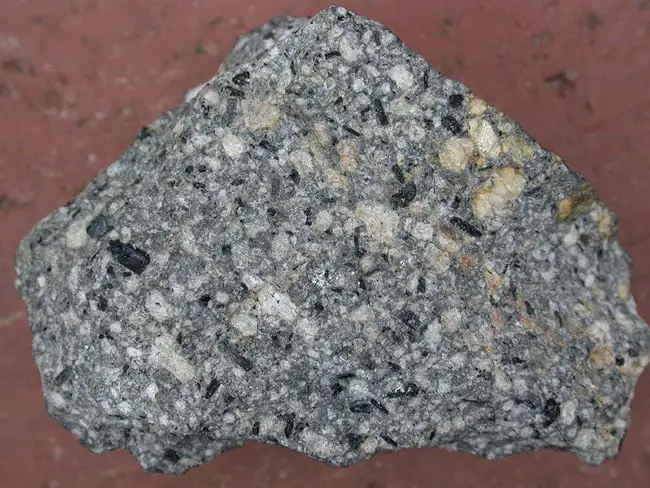
is an intermediate volcanic rock named after the Andes, andesite is usually grey-colored and porphyritic. Plagioclase, pyroxene, hornblende, and biotite may be present as phenocrysts, as well as, forming the finer groundmass. It occurs in the form of blocky or columnar jointed lava flows.
15- Trachyte
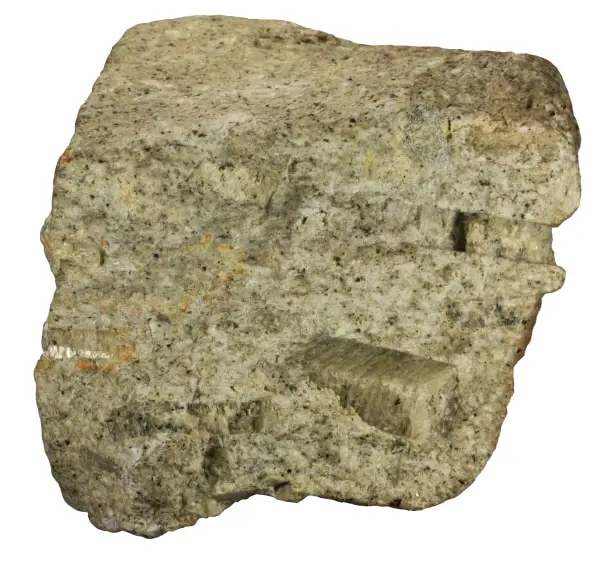
is the volcanic equivalent of syenite, trachyte’s composition is dominated by alkali feldspar. This is a major component both of the fine groundmass and of abundant phenocrysts, which are usually flow-aligned. It is often a vesicular lava and may also occur as a pyroclastic rock. It is usually grey-colored and frequently banded or streaky.
16- Dacite
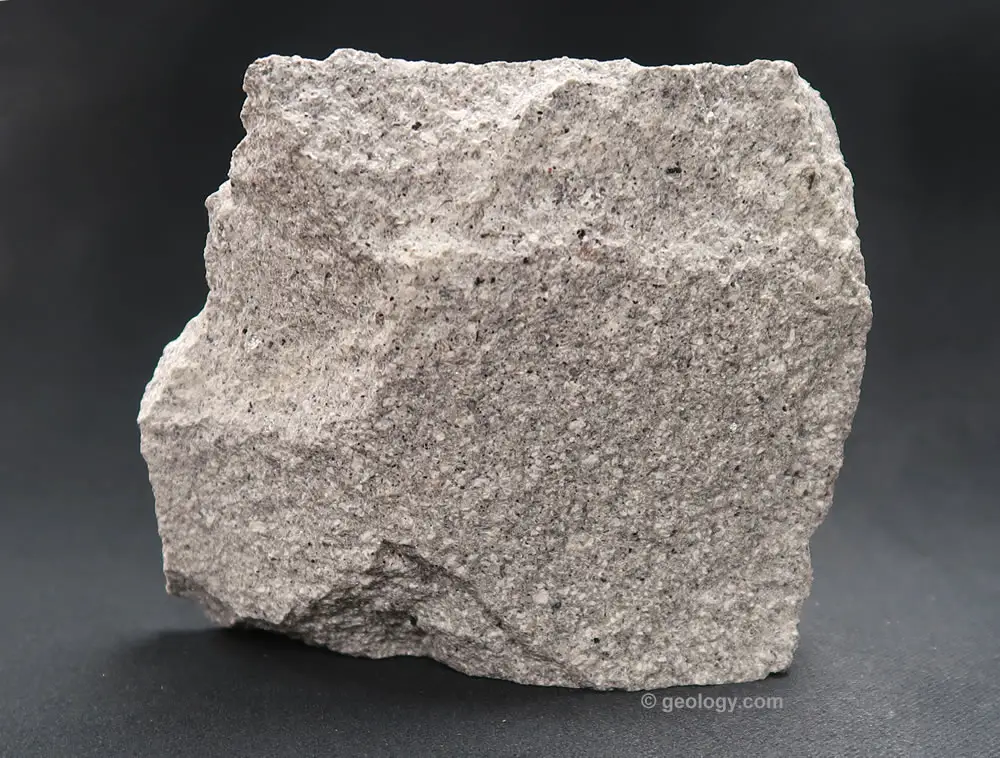
lies between rhyolite and andesite in composition. It is usually pink or a shade of grey and often flow-banded. Porphyritic varieties are common, with phenocrysts usually of plagioclase feldspar and/or quartz. It occurs with rhyolite in continental volcanic districts, and with andesite on continental margins.
17- Basalt

is the most common lava in the Earth’s crust, forming almost all of the ocean floor and also large areas on land. It is a fine-grained rock and, when fresh it is black in color, weathering to dark green, or brown. Some basalts are porphyritic with feldspar, augite, and olivine phenocrysts being common. Gas bubble holes give a vesicular texture, and these may be filled with later minerals, known as amygdales. The surface of basalt lava may be ropy and smooth, or blocky and rough.
18- Tuff
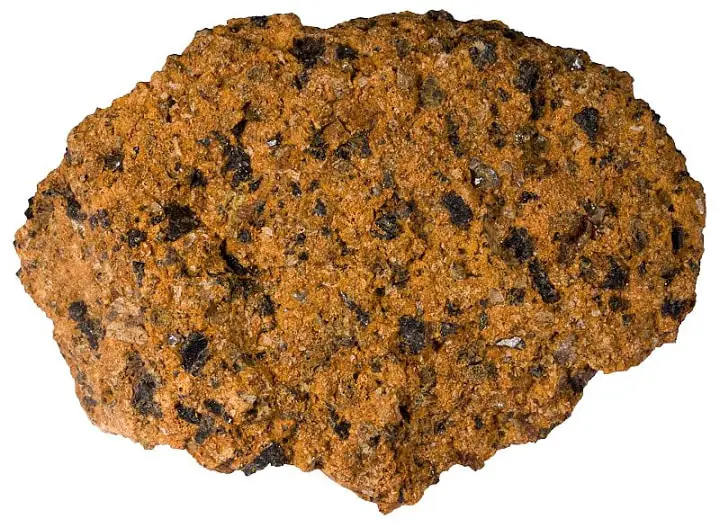
acid and intermediate magmas are more viscous than basic ones, and this means that the volcanicity associated with these magmas is more explosive, as greater pressures can build up. The major product of explosive volcanism is volcanic ash which, when settled, forms a rock called tuff.
19- Pumice

is a light grey or white, glassy volcanic rock, full of gas bubble holes, which may be spherical or compressed. These holes make it an extremely light rock that can usually float on water. It results from frothy acid lava and may be associated with rhyolite and obsidian. Pumice can be carried long distances from its source volcano by water or even wind.
Here is a box of igneous rocks specimen from amazon that has 12 samples. Get it now from the below link.
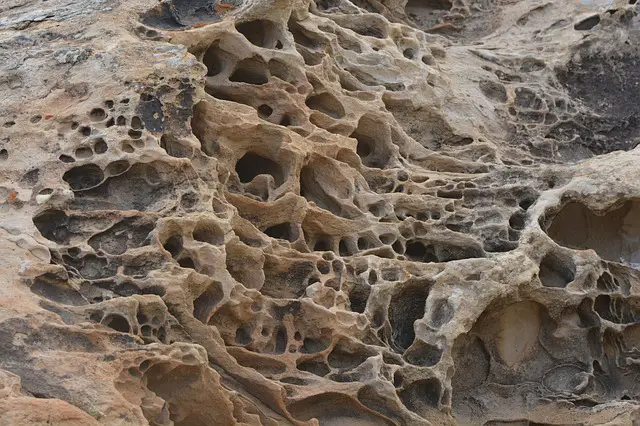
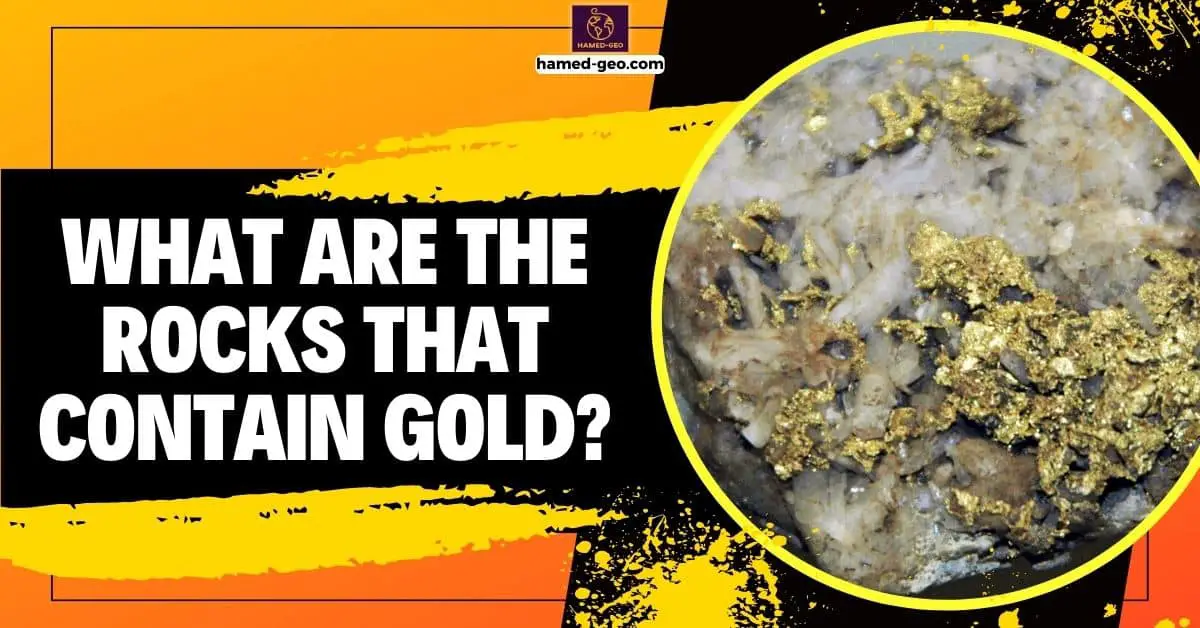

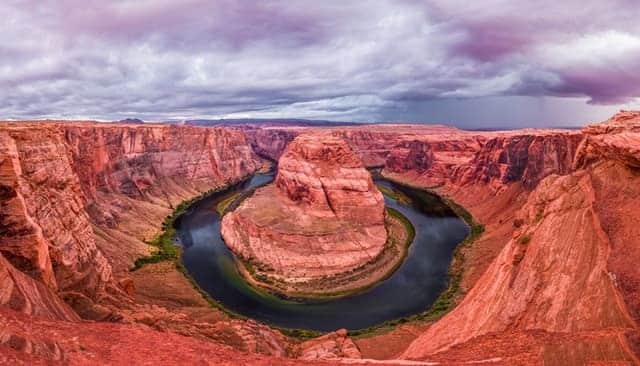
[…] What is Igneous Rocks? […]
[…] boundaries associated with mountain building, crustal deformation, metamorphism, earthquakes, and igneous activity. Thus, they are very complicated geologic […]
[…] very small crystals or glasses. Thus, cooling will occur deep on Earth. Large crystals are found in igneous rocks that formed by crystallization of magma which originated at great depths in the range of 950-450 Co […]
[…] major classes according to the processes that resulted in their formation. These classes are (1) igneous rocks, which have solidified from molten material called magma;(2) sedimentary rocks, those consisting of […]
[…] cycle processes that create and change the rocks. The rock cycle illustrate the three types of rock igneous, sedimentary, and metamorphic and the processes that form them. If you look at the illustration, […]
[…] within the Earth’s crust in equilibrium with a new set of environmental conditions. For example, igneous rock or metamorphic rock that forms deep in the Earth where the pressure and temperatures are very high […]
[…] and fore-flank are mainly composed of ophiolite basalts and dikes, which are characterized by their igneous composition and exotic geochemistry. Volcanic rocks are typically basaltic and are characterized by high K~2~O, […]
[…] or crustal fissures hence igniting a volcano. Upon solidification, lava or magma transforms into igneous rocks. Along with minerals, magma has trace quantities of dissolved gases including carbon dioxide (CO2), […]
[…] rocks are a group of igneous rocks that are composed of more than 90% mafic minerals such as olivine and pyroxene. These rocks are […]
[…] and magnesium. These rocks are characterized by their dark color and dense composition. Ultrabasic igneous rocks are formed from magma that has a very low viscosity, allowing it to flow easily and fill in gaps in […]
[…] the petrogenesis of different rock types, including igneous, sedimentary, and metamorphic […]
[…] is a highly volatile and potassic, ultrabasic igneous rock that generally can be found in the form of small volcanic pipes, sills, and dykes. It has an […]